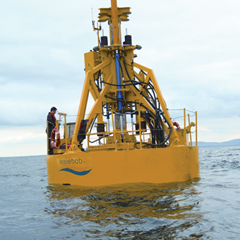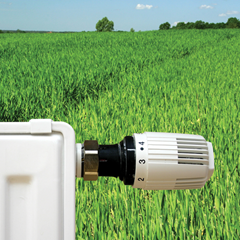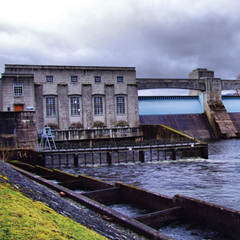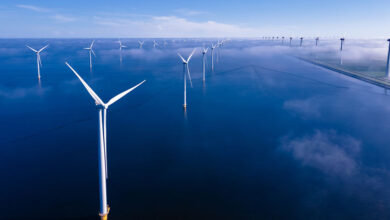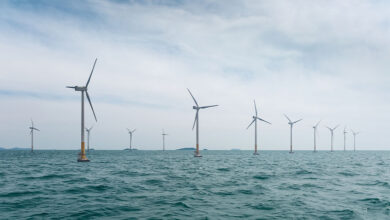Prioritising renewable energy
An overview of how Ireland, the UK, Northern Ireland and Scotland plan to meet European renewable targets and develop a sustainable energy future.
The UK’s dependency on energy imports could rise from 27 per cent in 2009 to 58 per cent in 2020. Ireland currently imports 89 per cent of its energy and Northern Ireland is 99 per cent dependent on imported fossil fuels for its energy needs. As a result there is a drive to create more indigenous renewable energy.
The UK is determined to move away from its reliance on coal to offshore wind, energy from waste, biomass and anaerobic digestion (as well as nuclear power and the development of carbon capture and storage).
Scottish ministers have executive devolution for energy matters. Their priorities are promoting renewable energy, implementing renewable obligation certificates and energy efficiency.
Energy policy is devolved to Northern Ireland, where the Executive has decided to focus on onshore and offshore wind and biomass.
The Republic of Ireland will continue to focus on onshore and offshore wind, biomass and new technologies such as ocean energy.
Each jurisdiction develops policy in line with European energy legislation. The 2009 Climate-Energy Legislative Package aimed at achieving (by 2020): a reduction of greenhouse gases by 20 per cent compared to 1990 levels; an increase in the level of renewable energy to 20 per cent by 2020; and a 20 per cent improvement on energy efficiency levels, compared to 2006.
That initiative incorporated the Renewables Directive which stipulated that 20 per cent of Europe’s final energy consumption (and 10 per cent of each member state’s transport energy) be from renewable sources by 2020.
Consequently, each member state developed its own targets.
In 2004, Northern Ireland and the Republic agreed to develop an all-island energy market. A step towards this came in 2007 when the Single Electricity Market (SEM) was established. The market encompasses approximately 1.8 million customers in the Republic of Ireland and 0.7 million in Northern Ireland.
In addition, interconnection is a pertinent issue for the four jurisdictions. While a 275kV overhead line currently connects Tandragee and Louth substations, it is comprised of two separate circuits and therefore is at risk of ‘system separation’ (making the disconnection of customer load a possibility). As a result, a second 400kV North/South interconnector, to be located in the counties of Tyrone, Armagh, Monaghan, Cavan and Meath, is out for consultation in both jurisdictions.
Work is under way on a 500MW electricity interconnector between Rush Beach in Dublin and Barkby Beach in north Wales. The interconnector will have a capacity of 500MW and is on target for completion in 2012.
A collaborative venture between the Scottish Government, the Northern Ireland Executive and the Government of Ireland, the ISLES project, is currently assessing the feasibility of creating an offshore interconnected transmission network and subsea electricity grid based on capturing wind, wave and tidal energy off the coast of western Scotland and in the Irish Sea.
Targets
• 16 per cent of all energy consumed to be from renewable sources by 2020
• 40 per cent of electricity
• 12 per cent of heat
• 10 per cent of transport
Latest figures from the SEAI show that renewables accounted for 4.7 per cent of gross final energy consumption in 2009 (provisional). Of that, renewables accounted for 14.4 per cent of gross electricity consumption.
National priorities
Ireland’s energy white paper: ‘Delivering a Sustainable Energy Future for Ireland’ (2007-2020) set the following priorities:
• ensuring security of energy supply;
• promoting the sustainability of energy supply and use; and
• enhancing the competitiveness of energy supply.
Onshore wind
Windfarms: 110
Installed capacity: 1,379MW
Offshore wind
Arklow Bank project
Installed capacity: 25MW
Gate 3 projects: Carrickmines (364MW) and Oriel (237.5MW)
Hydro
Hydro-electric generators: 14 Installed capacity: 212MW Micro hydro-electric generators: 52 Installed capacity: 25.1MW Ocean
Target: 500MW of installed wave capacity by 2020
A number of wave energy device prototypes are in development in Irish waters but a commercial wave energy device does not exist yet.
Biomass
Target: 30 per cent biomass co-firing in Ireland’s three state-owned peat-generation stations by 2015 2008 progress: 3.8 per cent
Targets
• 15 per cent of all energy consumed to be from renewable sources by 2020
• 12 per cent of all energy consumed to be from renewable sources by 2012
• 40 per cent of electricity
• 10 per cent of heat
The current share of electricity generated from renewable sources is just under 10 per cent.
National priorities
The 2010 Strategic Energy Framework identified the following priorities:
• build cost competitiveness;
• ensure security of supply;
• enhance sustainability; and
• develop energy infrastructure. Onshore wind
Windfarms: 26 Installed capacity: 347.7MW
DETI believes Northern Ireland will reach its 2012 target of 12 per cent due to its wind energy.
Offshore
Potential offshore wind, wave and tidal development sites: 8 2020 capacity targets: 600MW offshore wind energy 300MW tidal energy
Two separate, parallel, competitive tender rounds are planned for offshore wind and tidal stream later this year. (see page 40)
Bio-energy
A cross-departmental Bio-energy Action Plan aims to:
• raise awareness and understanding of the benefits and opportunities of bioenergy;
• create and maintain a supportive and encouraging policy and regulatory framework;
• encourage and support targeted investment; and
• encourage focused research that is relevant to Northern Ireland.
Targets
• 15 per cent of all energy consumed to be from renewable sources by 2020
• 30 per cent of electricity
• 11 per cent of heat
• 10 per cent of transport
In 2010, renewable accounted for 6.8 per cent of electricity, 1.8 per cent of heating and cooling and 3.6 per cent and 2.9 per cent of transport (renewable transport fuels accounted for 3.6 per cent of road transport fuels in 2010). Overall, renewable energy provisionally accounted for 3.3 per cent of energy consumption.
National priorities
The UK renewables policy framework is made up of three key components:
• providing financial support for renewables;
• unblocking barriers to delivery; and
• developing emerging technologies.
The July 2011 UK Renewable Energy Roadmap sets out actions for the UK Government that will “complement” parallel activity being undertaken by the devolved administrations. These include:
Onshore wind – provide long-term certainty for investors through electricity market reform and a managed transition from the Renewables Obligation.
Offshore wind – provide up to £30 million of direct government support for offshore wind cost reduction over the next four years.
Marine energy – provide up to £20 million over the next four years to support innovation in wave and tidal devices.
Biomass electricity – publish a UK Bio-energy Strategy.
Biomass heat – introduction of the Renewable Heat Incentive (RHI).
Ground source and air source heat pumps – introduction of the RHI for non-domestic installations and the Renewable Heat Premium Payment for eligible domestic scale heat pumps.
Renewable transport – support the market for plug-in vehicles by making up to £30 million available for investment in recharging infrastructure and providing a grant of up to 25 per cent of the purchase price (capped at £5,000) for eligible electric, plug-in hybrid or hydrogen fuel cell cars.
The Coalition’s Programme for Government states that “climate change is one of the gravest threats we face.”
Targets
• 30 per cent of all energy consumed to be from renewable sources by 2020
• 100 per cent (equivalent) of electricity demand
• 11 per cent of heat
• 10 per cent of transport
Scotland aims to generate twice the electricity it needs i.e. 50 per cent used in Scotland and 50 per cent exported. Over 50 per cent of all electricity will be from renewables (accounting for the 100 per cent equivalent of the domestic demand) and the remainder from non-renewable sources.
In 2009, 20.9 per cent of all Scottish-generated electricity came from renewable sources. This equated to the equivalent of 27.4 per cent of electricity demand. The shares for renewable heat demand and renewable transport demand were 2.8 per cent and 1 per cent respectively.
National priorities
The 2009 Scotland Renewable Action Plan identified the following priorities:
• establish Scotland as a UK and EU leader in the renewable field;
• ensure maximum returns for the domestic economy; and
• meet targets for energy from renewables, and for emissions reductions, to 2020 and beyond.
Hydro
Hydro-electric generators: 145 Installed capacity: 1,500MW
Future projects: Two large-scale new pumped storage schemes in the Central Highlands 900MW
Potential for small hydro schemes: 7,000
Potential capacity: 1,204MW
Offshore wind
In 2009 the Crown Estate granted exclusivity rights to nine offshore sites with the potential to generate more than 6GW of offshore wind power.
Onshore
Windfarms: 117 (1,367 turbines)
Installed capacity: 2.4GW
Future projects: 20 (450 turbines)
Potential capacity: 1GW

